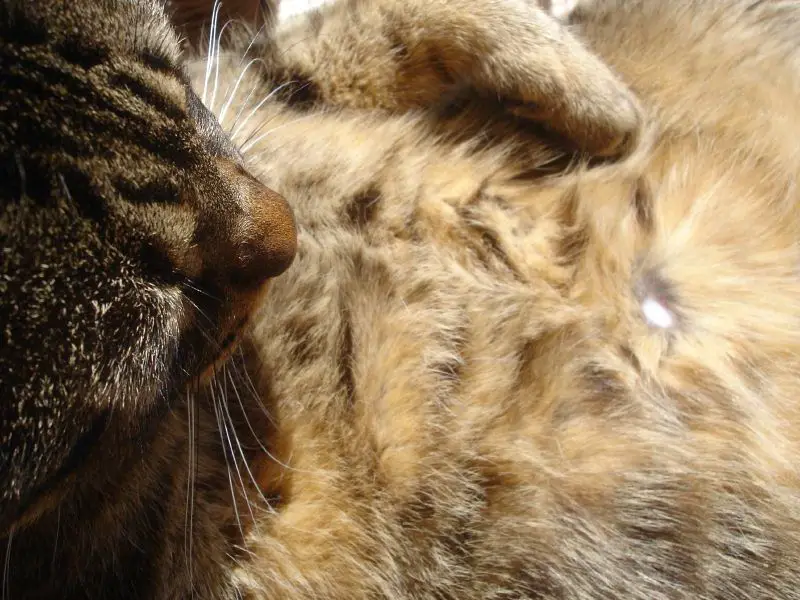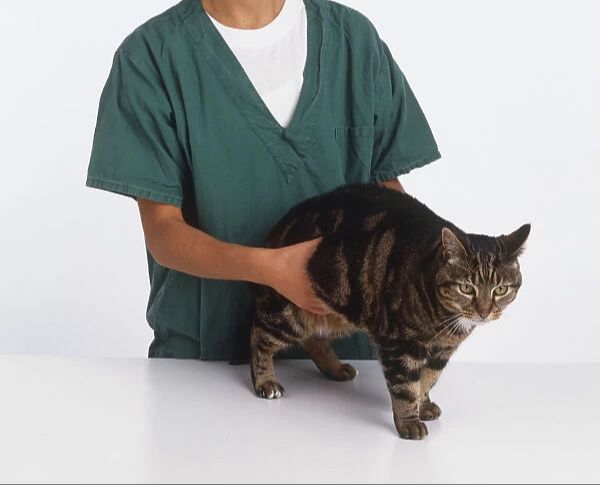This article will examine whether cats have belly buttons. Many pet owners may have noticed a small scar on their cat’s belly and wondered about its purpose and origin. To understand if this scar is indeed a belly button, we will look at cat anatomy and the role of belly buttons in mammals.
A belly button forms during gestation as the attachment site for the umbilical cord, which provides nourishment to the developing kitten in the womb. After birth, the cord falls off leaving behind a scar – the belly button. So the main question we will explore is, do cats have similar belly button scars like humans?
By reviewing kitten development, belly button function, and examining cat anatomy, we will determine if cats indeed have belly buttons.
What Are Belly Buttons?
Belly buttons are the remnants of umbilical cords from when mammals were in their mother’s womb. The umbilical cord connects a developing embryo or fetus to the placenta, allowing nourishment and oxygen from the mother to reach the baby. According to National Geographic, “Your belly button, also called your navel, is where your umbilical cord attached you to your mother before you were born. All mammals have belly buttons—a scar from where their umbilical cord was severed at birth.”

The umbilical cord contains two arteries and one vein surrounded by a jelly-like substance called Wharton’s jelly. The umbilical arteries carry waste from the fetus to the placenta, while the umbilical vein brings oxygen and nutrients from the mother’s blood supply to the fetus. When mammals are born, the umbilical cord is cut and clamped off, leaving behind the belly button or navel.
So in summary, belly buttons are essentially scars that mark where the umbilical cord was attached before birth. They signify that the animal developed inside its mother’s womb and received nourishment through an umbilical cord.
Kitten Development In The Womb
Kittens develop in the womb attached to a placenta and umbilical cord that provides nourishment. The placenta is an organ that develops in the lining of the uterus during pregnancy. It supplies oxygen and nutrients from the mother to the developing kittens via the umbilical cord. Each kitten has its own umbilical cord and is contained in its own sac called the amniotic sac.
In the womb, the umbilical cord connects the developing kitten to the placenta and acts as the lifeline, providing everything the unborn kitten needs to grow. The nutrients and oxygen from the mother cat are transferred through the placenta and umbilical cord into the kitten’s bloodstream. The umbilical cord also carries away waste from the developing kitten back to the placenta for disposal.
Once the kittens are fully developed, the mother cat begins labor and each kitten is born still attached to its umbilical cord. Kittens are born with belly buttons where the umbilical cord was attached. After birth, the mother cat bites through the cord, leaving behind a small belly button that takes a few days to fully heal. Just like in humans, a cat’s belly button is simply a scar from where the umbilical cord was detached.
Source: Kitten development

Belly Buttons After Birth
After birth, the umbilical cord is clamped and cut, leaving behind the belly button on a newborn baby’s abdomen. The remaining umbilical cord stump will eventually dry up and fall off within the first couple weeks of life, leaving behind the belly button.1 Once the umbilical cord stump falls off, the belly button does not serve any further purpose.
When the umbilical cord falls off, it leaves a small wound on the newborn’s belly. This wound will heal and close up completely within a few days after the cord drops off. While the belly button wound is healing, it is important to keep it clean and dry to prevent infection.
After the belly button wound fully heals and seals shut, the belly button no longer has an open passageway into the abdomen. The belly button becomes simply a scar in the location where the umbilical cord was once attached. Unlike when a baby is in the womb, the belly button does not connect to any internal organs after birth and healing.
While the belly button served the critical purpose of delivering nourishment and oxygenated blood from mom to baby during pregnancy, after birth, it is just a healed scar with no remaining utility. The belly button’s role in development is over once the umbilical cord falls off shortly after delivery.
Why Do Kittens Have Belly Buttons?
Kittens have belly buttons because they had umbilical cords providing nourishment in the womb (https://basepaws.com/blog/do-cats-have-belly-buttons). The umbilical cord connects a developing kitten to its mother’s placenta while in the womb. Oxygen and nutrients from the mother’s blood supply travel through the umbilical cord to the kitten. The kitten’s belly button marks the spot where the umbilical cord was attached.
After a kitten is born, the umbilical cord is clamped off and tied, leaving behind the kitten’s belly button. The belly button remains even though it no longer serves a purpose. Just like in human babies, a kitten’s belly button simply marks the remnants of where the umbilical cord was once connected.
Differences Between Kittens And Adult Cats
While kittens have prominent, visible belly buttons, adult cats’ belly buttons are much more difficult to detect. There are a few key differences that explain this change.

Kittens are born with an umbilical cord still attached to their belly button. The cord connects them to their mother in the womb, providing nourishment. After birth, the cord dries up and falls off within a few days, leaving behind the noticeable belly button.
According to veterinarians, a kitten’s belly button is initially an “outie” like a human infant’s (Cats.com). It protrudes slightly from the abdomen. As kittens grow, the belly button gradually flattens out and becomes less pronounced.
In adult cats, the belly button is more of an “innie” that sits flush with the surface of the skin. It resembles a small vertical slit or dot rather than a protruding nub. The belly button may also be concealed by fur in long-haired cat breeds. With the umbilical cord gone and abdominal muscles developed, the belly button turns inward and becomes harder to see.
While less visible, adult cats still have belly buttons marking the spot where they were connected to their mother in the womb. It simply becomes integrated into the abdomen as cats mature.
Finding The Belly Button On Adult Cats
While kitten belly buttons are usually visible, locating the belly button on an adult cat can be tricky. As cats grow, the belly button scar tends to become hidden by fur. Here are some tips for finding your adult cat’s belly button:

Look for a small, round scar on your cat’s belly, near where the hind legs meet the abdomen. The scar may be more visible on short-haired cats. For long-haired cats, you may need to part the fur to see it. Try blowing on the fur or using your fingers to gently move the hair aside.
Examine the area closely under good lighting. The belly button will likely blend in with the skin and be challenging to spot. Run your finger gently over the skin to feel for a slight dip or groove.
Have your cat lie on its back during the search. Gravity will cause the skin to stretch a bit, which can make the scar pucker up and be more visible. Give your cat a treat or rub its belly to keep it relaxed.
Try searching right after a bath or brushing, when the fur is flattened down. Bathing also removes oils that cause fur to clump together and obscure the view.
Be patient. Finding a belly button on some cats can take repeated tries over several days. But with a careful inspection, you should eventually locate this subtle body feature.
Sources:
https://www.rover.com/blog/do-cats-have-belly-buttons/
Why Is The Belly Button Hard To See?
There are a few reasons why a cat’s belly button becomes hard to see in adulthood:
The umbilical cord scar closes up as the kitten grows. According to VCA Animal Hospitals, the umbilical ring fully closes within the first week after birth [1]. As this closure occurs, the belly button becomes less distinct and prominent on the skin.
Fur grows over the belly button region. Kittens are born with minimal fur coverage. But as they mature, longer fur grows on their belly which conceals the faint scar tissue of the navel [2].
The belly button fades over time. Even as a prominent scar on newborn kittens, the belly button still flattens out and becomes less visible as the cat ages. The scar tissue blends in with the surrounding skin and fur [3].
In summary, the belly button becomes obscured due to natural closure of the umbilical ring, fur growth, and fading of the scar over time. These factors make it very difficult to locate the belly button on adult cats through casual observation.
Do Some Cats Not Have Belly Buttons?
While the vast majority of cats have belly buttons, there are some rare exceptions. One example is cloned cats produced through somatic cell nuclear transfer. In this artificial cloning process, the umbilical cord connecting a kitten to its mother in the womb is never formed. Therefore, cloned cats lack a belly button since they did not develop one in utero.
According to a 2004 study published in Nature, researchers successfully cloned the first cat named CopyCat using this method. As a clone that bypassed natural development in the womb, CopyCat was born without a belly button.
However, cloned cats like CopyCat represent extremely rare exceptions. Almost all cats born through natural reproduction will have a belly button or umbilical scar. Even though it can be difficult to find, nearly every cat’s belly does have this remnant from their time in the womb attached to their mother by an umbilical cord.
So while cloning technology can sometimes produce belly button-less cats, the overwhelming majority of felines have this small scar that marks where their umbilical cord once connected them to their mother’s placenta.
In Conclusion
To summarize the main points, kittens are born with belly buttons that form from their umbilical cords while in the womb. After birth, the belly button remains but becomes less visible over time as the kitten grows into an adult cat. The belly button does not fully disappear, but is often obscured by fur and fades as the cat ages. With patience and a careful look under the fur, cat owners can find the faint remnant of a belly button on most adult cats.
So while it can be tricky to locate, the answer is yes – cats do have belly buttons! They are a reminder of the kitten’s development before birth. The belly button serves an important purpose for kittens, allowing nutrients to flow from mom to baby. This crucial role is why all cats are born with a belly button, even if it becomes harder to find later in life.

